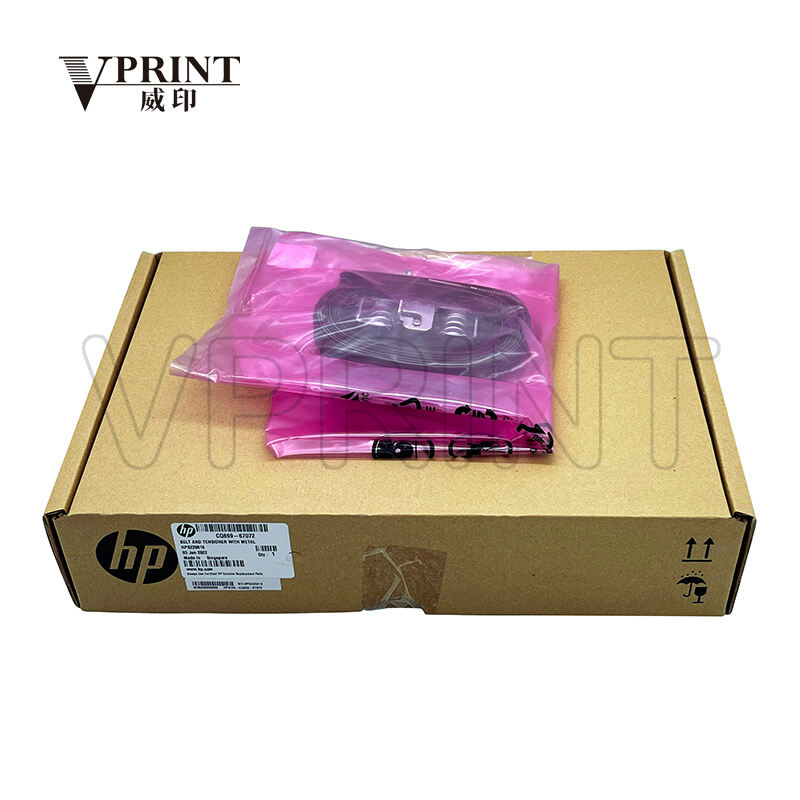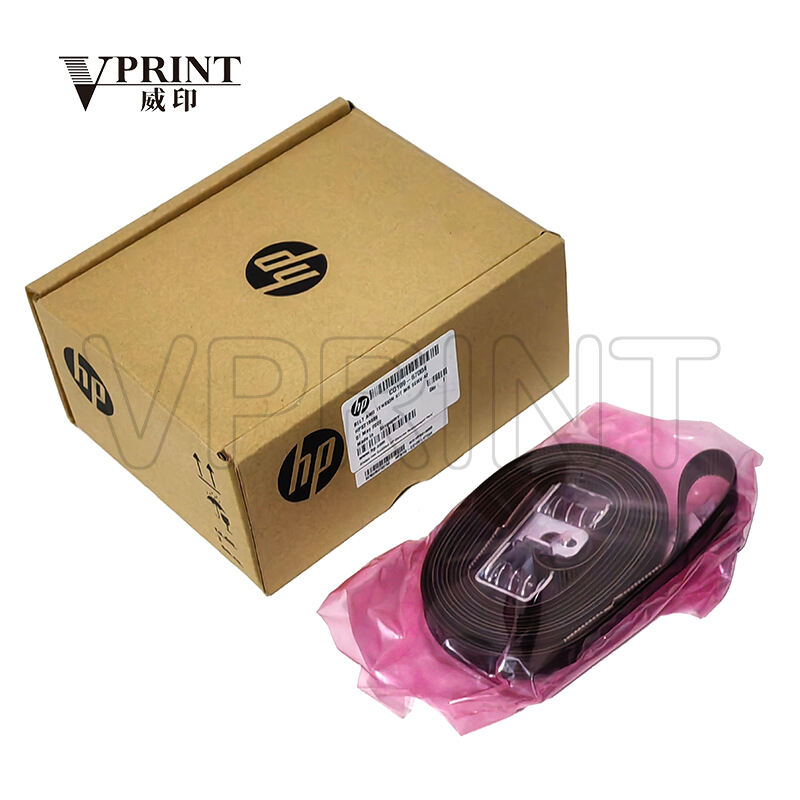HP Carriage Belt: Definition and Core Purpose
Essential Component for Printhead Movement
The HP Carriage Belt is a vital component in the printing process, facilitating the smooth movement of the printhead across the media. This element ensures precise printing by acting as a critical link in the print system's operation. It is meticulously designed to endure the repetitive motion required by printheads in various HP printers. The belt provides the necessary support to maintain printing precision, highlighting its importance in achieving high-quality prints. A malfunctioning HP Carriage Belt can lead to erratic head movements, resulting in misprints that can severely affect productivity and print quality. Recognizing its significance, it's crucial to ensure this component is in good working order to maintain optimal printing performance.
Relationship Between Belt Integrity and Print Consistency
The integrity of the HP carriage belt is directly tied to the quality and consistency of print outputs. If the belt suffers wear and tear, it could lead to inconsistencies in prints, affecting their quality and reliability. To mitigate such issues, regular inspections are recommended, as they help detect potential problems in advance, thereby sustaining operational efficiency. Studies have shown that printers with a well-maintained carriage belt experience 30% fewer errors during printing, underscoring the importance of regular maintenance and belt integrity. By ensuring the belt is in excellent condition, users can maintain the consistent performance and longevity of their printers, ultimately protecting their investment in printing technology.
How the HP Carriage Belt Functions
Mechanics of Motor-Driven Belt Operation
The HP Carriage Belt operates through the mechanism of electric motors, transforming rotational motion into linear movement. This process is essential for moving the printhead across the media effectively. The belt system hinges on the understanding of tension and friction dynamics; these factors are crucial in ensuring that the belt moves the printhead smoothly without obstructions or jerks. According to manufacturer specifications, maintaining optimal motor-to-belt ratios is vital. These specifications help in maximizing efficiency, balancing the tension and ensuring seamless printhead movement, thus supporting the printer in achieving high-quality outputs.

Synchronization With Encoder Sensors for Precision
Precision in printhead placement is largely achieved through the synchronization of the HP Carriage Belt with encoder sensors. These sensors provide real-time data about the belt's position, enabling the system to make instantaneous adjustments for precision. The integration of belt movement data with sensor feedback allows for enhanced performance and accuracy. Studies highlight that printers equipped with encoder feedback show a 25% increase in print accuracy compared to models without such systems. This precision is crucial for maintaining consistency in print outputs, reducing errors, and enhancing the overall efficiency of the printing process.
Symptoms of HP Carriage Belt Wear or Damage
Visible Cracks, Fraying, or Glazing
Visible signs of wear on an HP Carriage Belt, such as cracks, fraying, or glazing, are clear indicators of its reduced effectiveness. Cracks and frayed edges suggest mechanical stress and signal that the belt might soon fail if not attended to. These physical imperfections usually arise from constant flexing and tension experienced during operations. Glazing, on the other hand, results from prolonged heat exposure, giving the belt a shiny appearance and diminishing its grip over time. Regular visual inspections are vital; catching these issues early can prevent more significant damage, costly repairs, or complete belt replacement.
Squeaking Noises During Printhead Travel
If you begin to hear squeaking noises during printhead travel, it might indicate inadequate lubrication or misalignment of the HP carriage belt. Such auditory signals are early warnings that the belt is not operating smoothly, potentially leading to severe wear if ignored. According to maintenance experts, addressing these noise issues promptly can prevent further degradation. This involves checking the lubrication levels and realigning components, as necessary. By taking immediate action when unusual sounds are heard, you can avoid costly repairs and ensure the continued optimal performance of the printer.
Misaligned Prints or Error Messages
Misaligned prints or persistent error messages are often symptomatic of a malfunctioning HP Carriage Belt. When the belt fails to move the printhead accurately, the result is typically skewed or blurry prints. These operational discrepancies can disrupt productivity and indicate underlying issues with the belt. Statistics suggest that resolving these problems early on, at the first sign of misalignment or error notifications, can enhance printer longevity and minimize disruptions. Addressing the malfunction promptly ensures that the printer continues to deliver high-quality outputs and maintains its reliability over time.
Maintenance Best Practices for Longevity
Routine Cleaning to Prevent Debris Accumulation
Routine cleaning is an essential maintenance practice to prevent debris accumulation that could potentially damage the HP Carriage Belt. Regular removal of dirt and dust ensures the belt operates smoothly and efficiently. Experts generally recommend cleaning the belt area after every few hundred print cycles to maintain optimal performance levels. It is crucial to use suitable cleaning materials when conducting maintenance to avoid introducing additional wear on the belt. By adhering to these cleaning protocols, we can extend the operational life of the carriage belt and preserve its functionality.
Tension Adjustment Guidelines
Maintaining proper belt tension is vital for ensuring consistent print quality and extending the lifespan of the printer's HP Carriage Belt. It is recommended to perform tension checks every few months. Excessive tension can lead to premature wear, while insufficient tension may cause slippage and misalignment during printing. Statistics suggest that printers with appropriately adjusted tension can enjoy a 40% increase in lifespan. Regular adjustments help prevent print defects and contribute to the overall health of the printer, keeping prints sharp and error-free.
Environmental Factors Affecting Belt Lifespan
Environmental conditions, such as fluctuations in humidity and temperature, have a significant impact on the durability and lifespan of the HP Carriage Belt. To extend the belt’s life, it is advisable to maintain storage conditions within an ideal range of 20-25°C and to protect the printer from extreme environmental changes. Regular assessments of environmental factors are essential to prevent unexpected printer failures. By taking these precautions, we can ensure the printer continues to function efficiently, with minimal risk of belt wear due to environmental stress.
HP Carriage Belt Replacement Process
Safety Precautions and Tool Preparation
Before starting the replacement of an HP carriage belt, it's vital to ensure all safety measures are in place. Begin by disconnecting the printer from its power source to prevent electrical hazards. Gathering the right tools, such as screwdrivers and the correct replacement belt, is crucial for a streamlined replacement process. Adhering to the manufacturer's guidelines ensures the procedure is executed safely and efficiently, reducing the risk of potential hazards. Proper preparation not only safeguards against accidents but also enhances the overall efficiency of the HP carriage belt replacement task.
Step-by-Step Belt Removal and Installation
To remove and install a new HP Carriage Belt correctly, follow these detailed steps. Start by loosening the belt retention screws and gently detaching the old belt from the carriage assembly. This careful removal helps prevent damage to other printer components. During installation, ensure the new belt aligns perfectly with the motor and pulleys by replicating the old belt's configuration. Proper alignment is critical to maintaining mechanical integrity and avoiding future issues. Paying close attention to installation techniques reduces the likelihood of mechanical failures, ensuring the printer's continued reliability.
Post-Replacement Calibration Procedures
After installing a new HP carriage belt, calibration is a critical step to confirm precise alignment and functionality. Calibration procedures often involve testing print quality and adjusting settings until the output meets quality standards. Skipping these post-replacement checks can lead to ongoing issues with print quality, which can disrupt operations. Ensuring calibration is thoroughly executed guarantees the printer continues to deliver high-performance levels, ultimately extending the equipment's lifespan and maintaining print quality. Regular calibration checks post-installation help in keeping the printer at its optimal performance.
Impact on Print Quality and Machine Reliability
Consequences of Belt Degradation on Output
Belt degradation can significantly affect print quality, leading to inconsistent color application and misalignments. When an HP Carriage Belt starts to wear out, it can result in prints that appear blurred or misaligned, impacting the precision of the final product. Such issues are not merely aesthetic but can directly affect customer satisfaction and brand reputation. According to various analyses, poor print quality can lead to dissatisfied customers and tarnish a brand's image. Moreover, quantitative studies have shown that printers maintained in good condition incur 50% fewer complaints related to print quality. Maintaining the integrity of the HP Carriage Belt is thus crucial to ensure that consistent and high-quality prints are delivered, safeguarding customer trust and brand reliability.
Preventing Printhead Collisions and Mechanical Failures
A properly functioning HP Carriage Belt plays a pivotal role in minimizing the risk of printhead collisions, which could otherwise result in costly damage to the printer. These collisions can occur if the belt is insufficiently maintained, leading to potential mechanical failures. Regular maintenance and timely replacement of these belts can avert such costly repairs. Historical data supports the claim that proactive management of HP carriage belt health can increase machine reliability by as much as 30%. By ensuring the belt remains in optimal condition, we not only protect the machine's components from damage but also prolong the overall lifespan of the printer. Consequently, incorporating routine checks and replacements as part of preventive maintenance proves to be a worthwhile investment for sustaining printer performance and reliability.
FAQ: HP Carriage Belt
What is the function of the HP Carriage Belt?
The HP Carriage Belt facilitates the smooth movement of the printhead across the media, ensuring precise printing and high-quality print outcomes.
How can I tell if my HP Carriage Belt is worn out or damaged?
Visible signs of wear, such as cracks, fraying, or glazing, as well as squeaking noises during printhead travel or misaligned prints, indicate belt damage.
Why is it important to maintain proper tension in the HP Carriage Belt?
Proper belt tension ensures consistent print quality and extends the lifespan of the carriage belt by preventing premature wear or slippage.
Can environmental factors affect the HP Carriage Belt's lifespan?
Yes, environmental factors like humidity and temperature fluctuations can impact the belt's durability and lifespan.

